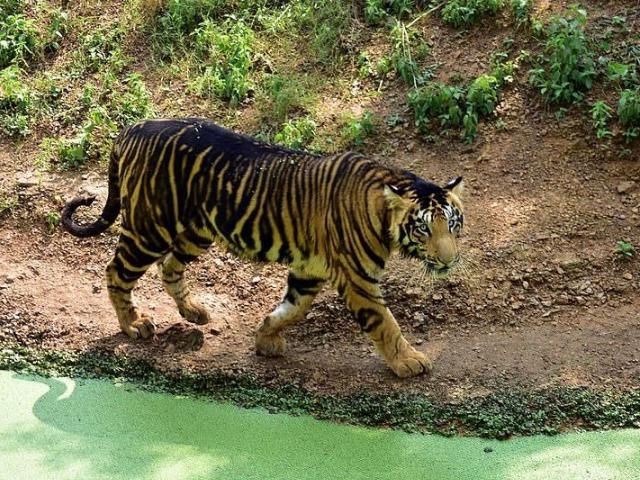Tyger Tyger, burning bright,
In the forests of the night
William Blake, one of the celebrated English poets of 18th century, may have not written this poem had he seen the black tigers of Simlipal tiger reserve of Odisha. Blake’s source of inspiration, literary critics have written, was the flame-like appearance of a tiger’s stripes. But Simlipal tigers have dominant black stripes and have been in news again after camera traps captured its images in Odisha jungles in the last week of July. A black tiger was spotted marking its territory on a tree trunk at Similipal tiger reserve (STR) in the Mayurbhanj district of Odisha. Earlier, this year, we had visuals of a golden tiger coming from Kazirangana national park of Assam. We already have white tigers and the first such animal was spotted in Rewa district of Madhya Pradesh in 1951. Actually, we can have as many as 14 types of colouration patterns in tigers including the one that was “ burning bright” in Blake’s “The Tyger” published in 1794.
Black Tiger Family Of Simlipal
Also read: Rising Tiger Numbers Midst Shrinking Forest Cover Makes No Sense
In 2015, a normal tigress was found with a melanistic cub, while in 2016, a melanistic tigress was photographed with her three cubs, two of which were black. According to L.A.K. Singh, people believe that Similipal is the only forest in India which has an established presence of melanistic tigers; this belief is not entirely true. “Few know that in March 1997, a melanistic tiger was also sighted in Satkosia Gorge Sanctuary (part of Satkosia Tiger Reserve) in Odisha. “What is even more unusual is that neither are their ( black tiger )activities and behavioural traits different from the usual tigers nor do they face problems of acceptance within the tiger community, ”former honorary wildlife warden of STR, Bhanumitra Acharya said. Black tigers can also be found at the Nandankanan Zoo, Bhubaneswar, where they are caged and are healthy. In all these cases, several areas of the tigers’ coats were abnormally dark or black, and such tigers were termed pseudomelanistic (pseudo meaning false; melanistic is dark/black coloured).
Inbreeding leads to Black Colour, Cause of Concern
Also read: Golden Tiger And Its Gloomy Roar In Kaziranga National Park
Raising an alarm, the findings said, “ Genetic analyses of other tiger populations from India and computer simulations suggest that the Similipal black tigers may have arisen from a very small founding population of tigers and are inbred. Similipal tigers are an isolated population in eastern India and gene flow between them and other tiger populations is very restricted. This has important implications for tiger conservation as such isolated and inbred populations are prone to extinction over even short periods of time.” While colour aberration of tigers may be a tourist attraction, it is a cause of concern and does not augur well in terms of their biological or conservation implications in the wild, said LAK Singh . “More aberrations in nature mean all is not well with the natural gene pool, making it necessary to have increased tiger corridors to reduce genetic depression,” he says.
Jungle Bottlenecks and Black Tigers
The important connectivity with STR are patches of forests connecting the tiger reserve with Badampahar reserve forest in the west, Kuldiha sanctuary in the south eastern side and upto Atai reserve forest in Keonjhar district in the south western side. In 20010, the National Tiger Conservation Authority (NTCA) identified a potential connectivity between STR and Satkosia tiger reserve . It is a very long corridor, but is highly fragmented due to intense mining activities, power stations and a large number of human habitations. According to a study by the Wildlife Institute of India, conducted in 2014, there are more than 250 villages in and around this corridor. Simlipal is subjected to high anthropogenic pressure due to presence of 68 villages with the reserve and about 1200 villages in the periphery . The local people still follow a unique tradition of ritual mass hunting called Akhand Shikar. Control on this practice is a major challenge.
Also read: The Legacy of White Tigers - Mohan, Virat to Mukundpur Safari
For Satkosia Tiger Reserve, Similipal is considered to be the source population of tigers because of seclusion of Satkosia from other connected protected areas. Conservationists hope that the proposed corridor will help recover tiger populations in the Satkosia Tiger Reserve in the near future. At present, tiger densities in both Similipal and Satkosia are depressed and there is a lack of a source population to ensure tiger occupancy within the larger landscape. With appropriate protection and managerial changes, tiger populations in both these reserves can revive, but their long-term survival would depend on the gene flow between these populations. Tigers resort to inbreeding when their population is almost islanded without connectivity to other landscapes, which is mainly caused by habitat loss and destruction of corridors. A joint study by the National Centre for Biological Sciences and Cardiff University had flagged the concern that Indian tigers no longer possess 93% of their genetic variation.
Black, White, Blue And Ten More Colours
Also read: Tiger Corridor : Now Satpuda Melghat National Parks Connectivity At Risk
L.A.K. Singh has expressed the probability of “at least fourteen known types of body coloration in tigers” in his book “Born Black : The Melanistic Tiger in India” in 2002. They include (1) Stripeless White Tiger (2) Tigers with reduced stripe on white background ( 3) 'Lighter' WhiteTigers (4) 'Darker'White Tigers (5) Golden (Pallid) ( 6) Normal (light yellow) (7) Normal (8) Normal (deep yellow) (9) Rufous (10) Brown with dark stripes (11) Brown without stripes (12) Melanistic (13) Blue (14) Black .The appearance of tigers with aberrant coloration can be expected as a regular occurrence in some places but overall an extremely rare natural phenomenon.






Comments
Post a Comment